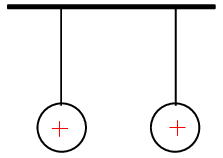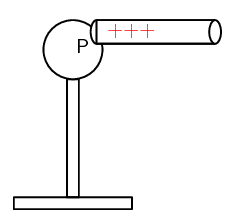What are the two types of charge called?
End of chapter exercises
|
Previous
Chapter summary
|
Next
17.1 Potential difference and emf
|
Electrostatics
Provide evidence for the existence of two types of charge.
Fill in the blanks: The electrostatic force between like charges is . while the electrostatic force between opposite charges is ..
I have two positively charged metal balls placed \(\text{2}\) \(\text{m}\) apart.
-
Is the electrostatic force between the balls attractive or repulsive?
-
If I now move the balls so that they are \(\text{1}\) \(\text{m}\) apart, what happens to the strength of the electrostatic force between them?
I have \(\text{2}\) charged spheres each hanging from string as shown in the picture below.

Choose the correct answer from the options below: The spheres will
-
swing towards each other due to the attractive electrostatic force between them.
-
swing away from each other due to the attractive electrostatic force between them.
-
swing towards each other due to the repulsive electrostatic force between them.
-
swing away from each other due to the repulsive electrostatic force between them.
Describe how objects (insulators) can be charged by contact or rubbing.
You are given a perspex ruler and a piece of cloth.
-
How would you charge the perspex ruler?
-
Explain how the ruler becomes charged in terms of charge.
-
How does the charged ruler attract small pieces of paper?
(IEB 2005/11 HG) An uncharged hollow metal sphere is placed on an insulating stand. A positively charged rod is brought up to touch the hollow metal sphere at P as shown in the diagram below. It is then moved away from the sphere.

Where is the excess charge distributed on the sphere after the rod has been removed?
-
It is still located at point P where the rod touched the sphere.
-
It is evenly distributed over the outer surface of the hollow sphere.
-
It is evenly distributed over the outer and inner surfaces of the hollow sphere.
-
No charge remains on the hollow sphere.
What is the process called where molecules in an uncharged object are caused to align in a particular direction due to an external charge?
Explain how an uncharged object can be attracted to a charged object. You should use diagrams to illustrate your answer.
Explain how a stream of water can be attracted to a charged rod.
An object has an excess charge of \(-\text{8,6} \times \text{10}^{-\text{18}}\) \(\text{C}\). How many excess electrons does it have?
An object has an excess of \(\text{235}\) electrons. What is the charge on the object?
An object has an excess of \(\text{235}\) protons. What is the charge on the object?
Two identical, metal spheres have different charges. Sphere 1 has a charge of \(-\text{4,8} \times \text{10}^{-\text{18}}\) \(\text{C}\). Sphere 2 has \(\text{60}\) excess electrons. If the two spheres are brought into contact and then separated, what charge will each have? How many electrons does this correspond to?
Two identical, insulated spheres have different charges. Sphere 1 has a charge of \(-\text{9,6} \times \text{10}^{-\text{18}}\) \(\text{C}\). Sphere 2 has \(\text{60}\) excess electrons. If the two spheres are brought into contact and then separated, what charge will each have?
Two identical, metal spheres have different charges. Sphere 1 has a charge of \(-\text{4,8} \times \text{10}^{-\text{18}}\) \(\text{C}\). Sphere 2 has \(\text{30}\) excess protons. If the two spheres are brought into contact and then separated, what charge will each have? How many electrons or protons does this correspond to?
|
Previous
Chapter summary
|
Table of Contents |
Next
17.1 Potential difference and emf
|
